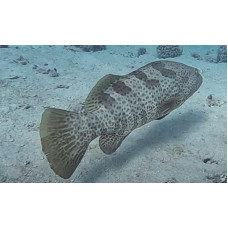Latin name
Epinephelus coioides
Other names
Brown-spotted rockcod, estuary cod, estuary rockcod, goldspotted rockcod, greasy cod, North-west groper, orange spotted cod, blue-and-yellow grouper.
Identification
It has an elongated body with a standard length of 2.9-3.7 times its depth. The dorsal profile of the head is flat or slightly convex between the eyes, the preopercle has enlarged teeth at the corners and a shallow notch just above the corner. The upper edge of the gill cover may be straight or slightly convex. There are 58-65 scales on the lateral line.
Features of fish fins
The dorsal fin has 11 spines and 13-16 soft rays, while the anal fin has 3 spines and 8 soft rays. The webs between the dorsal fin spines are conspicuously notched. The caudal fin is rounded.
Fish colouring
The head and body are light brown, lightening to a whitish tint on the back. The flanks have four oblique dark "H" shaped markings and 3-4 dark saddle-shaped spots on the back, while the head, body and fins are covered with numerous small brown or orange spots. The spots are larger and less numerous in juveniles, decreasing in size and increasing in number as the fish grows.
Distribution
It is distributed throughout the Indo-Pacific region. It is found along the east coast of Africa, from the Gulf of Suez south to Durban, South Africa. It is also found in Madagascar, Mauritius, and Reunion, as well as in the Persian Gulf and as far east as Palau and Fiji in the Pacific Ocean. Its range extends as far north as Japan and as far south as Australia. In Australia, it is found from Carnarvon, Western Australia, along the tropical northern coasts to remote islands in New South Wales. It has been sighted in the Mediterranean Sea off Israel.
Habitat
Marine, brackish, subtropical species. Depths from 1 to 100 meters. Inhabits coral reefs, especially along mainland coasts and large islands. Juveniles are often found in estuaries with sand, silt and gravel and in mangroves.
Size
Maximum published total length is 47 inches (120 centimeters) and maximum published weight is 33 pounds (15 kilograms). Maximum published age: 22 years.
Behavior
Solitary. At night, these fish partially burrow into the mud.
Food and feeding habits
It is a predatory species that hunts fish, shrimp, crabs and other bottom-dwelling crustaceans.
Reproduction
They are diandric protogynous hermaphrodites, some developing from juveniles to males, while others develop from complete females to males when they reach a length of about 67 centimeters (26 inches) and an age of 7.5 years. Off the coast of Papua New Guinea, they have been reported to gather in groups of about 1,500 individuals to spawn for 3 to 4 days each month on muddy and sandy bottoms. In the Gulf, the spawning season runs from March to June. Eggs and larvae are thought to be pelagic.
Fishing
They are mainly hunted with traps. Orange-spotted grouper are subject to overfishing. They grow slowly due to their lazy feeding habits, mature late and lay few eggs. The most sought-after large males have suffered the most, resulting in an imbalance between the sexes.
Relationship with a person
The flesh of these fishes has an excellent taste that reaches a high value in the markets.
| Classification | |
| Phylum | Chordata |
| Class | Actinopterygii |
| Squad | Perciformes |
| Family | Serranidae |
| Genus | Epinephelus |
| Species | E. coioides |
| Features | |
| Conservation status | Least Concern |
| Habitat | No information |
| Life span, years | 22 |
| Maximum body weight, kg | 15 |
| Maximum length, cm | 120 |
| Sailing speed, m/s | No information |
| Threat to people | Edible |
| Way of eating | Predator |
Orange-spotted grouper
Tags: orange spotted grouper



